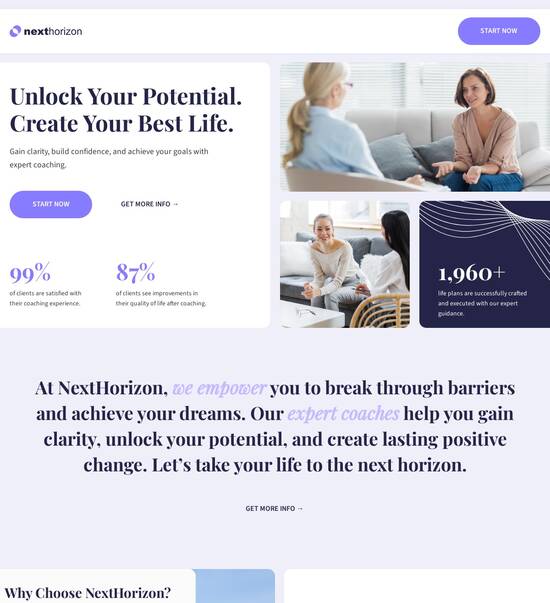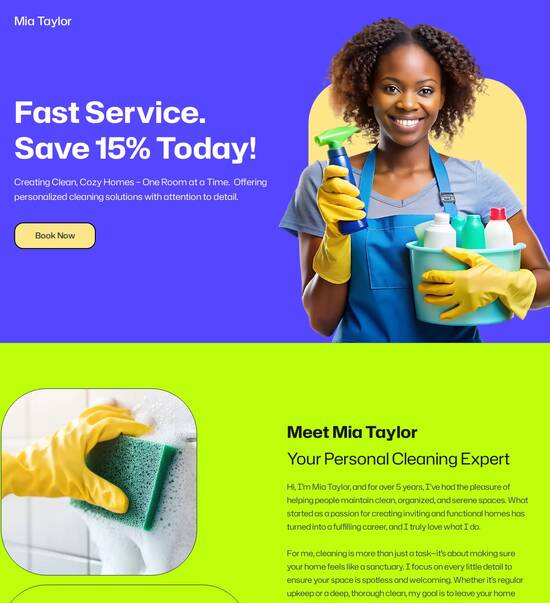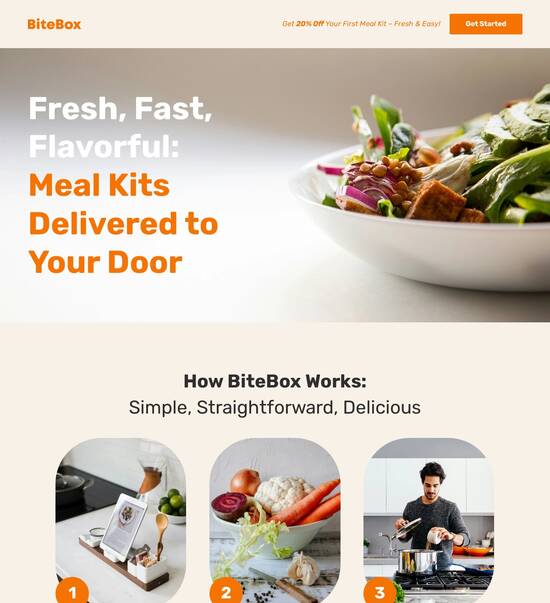
React.js optimized music streaming website template
Explore Similar TemplatesAbout template
Leverage our intuitive page builder and high-converting React.js optimized music streaming website template.
Recommended templates

Easy to build without coding
With the intuitive drag-and-drop builder, anyone on your team can create high-converting pages without any knowledge of code or design. Make enhancements to your landing page with custom widgets using Javascript, HTML/CSS, or third-party scripts.

Multiple layouts for any industry and goal
Select from 500+ landing page layouts built to boost conversions across industry-specific scenarios. Customize them by adjusting fonts, adding images, and generating on-brand content with the AI assistant. Quickly scale with Instablocks® and Global Blocks that you can save, reuse, and update globally.

Loads fast and looks polished on any device
Every template is responsive, which means they present professionally on any device and load blazingly fast with our Thor Render Engine. You can also power them up with Google AMP technology to deliver an unparalleled mobile experience and drive higher conversions.

Robust analytics & experimentation
Get real-time updates and reporting across all your devices, showing the number of visitors, conversions, cost-per-visitor, and cost-per-lead. Launch AI-powered experiments, run A/B tests, and use heatmaps to analyze user behavior, then optimize your landing page to maximize conversions.







Easy to build without coding
With the intuitive drag-and-drop builder, anyone on your team can create high-converting pages without any knowledge of code or design. Make enhancements to your landing page with custom widgets using Javascript, HTML/CSS, or third-party scripts.
Multiple layouts for any industry and goal
Select from 500+ landing page layouts built to boost conversions across industry-specific scenarios. Customize them by adjusting fonts, adding images, and generating on-brand content with the AI assistant. Quickly scale with Instablocks® and Global Blocks that you can save, reuse, and update globally.
Loads fast and looks polished on any device
Every template is responsive, which means they present professionally on any device and load blazingly fast with our Thor Render Engine.
Robust analytics & experimentation
Get real-time updates and reporting across all your devices, showing the number of visitors, conversions, cost-per-visitor, and cost-per-lead. Launch AI-powered experiments, run A/B tests, and use heatmaps to analyze user behavior, then optimize your landing page to maximize conversions.
All the features you need to build lead-generating landing pages
Explore more featuresLearn how to build top-performing landing pages for any goal
FAQs
Leading the way in building high-performing landing pages





A step-by-step guide for using Instapage to optimize landing pages
Creating high-converting landing pages is essential for maximizing your return on investment. Instapage provides marketers with a robust platform that simplifies the process of building and optimizing landing pages to ensure you capture leads effectively.
Understanding the versatility of Instapage
Instapage is designed to cater to various marketing needs, from small businesses to large enterprises. Its flexibility allows for customization based on specific industry requirements, making it suitable for sectors such as education, financial services, and tech.
- Wide range of templates: Choose from over 100 customizable templates to fit your brand's aesthetic and messaging.
- No coding required: Build landing pages easily with a drag-and-drop builder, ensuring speed and simplicity.
- Built-in optimization tools: Utilize A/B testing and heatmaps to evaluate and enhance page performance.
Constructing your landing page
The first step involves building your landing page using Instapage's intuitive tools. Here’s how you can get started:
- Select a template: Use one of Instapage's high-converting templates or start from scratch.
- Customize your layout: Drag and drop elements to create a unique landing page that aligns with your campaign goals.
- Incorporate lead generation tools: Use built-in forms and call-to-action buttons to encourage visitor engagement.
Optimizing for conversions
Once your landing page is constructed, the next step is optimization. This can significantly improve your conversion rates:
- Utilize heatmaps: Analyze user interactions on your page to identify sections that need modification.
- Conduct A/B tests: Experiment with different headlines, layouts, and images to find what resonates best with your audience.
- Integrate analytics: Use Instapage's analytics dashboard to track key performance metrics and make data-driven decisions.
Personalizing your marketing message
Finally, personalizing your content can drastically enhance engagement. Instapage allows you to tailor experiences based on user behavior:
- Dynamic text replacement: Customize headlines based on the visitor's source or keywords they've used.
- AdMaps: Align specific ads with unique landing pages to ensure a seamless user experience.
- Audience-specific metrics tracking: Measure performance based on distinct audience segments to refine your targeting.
By following these steps, marketers can leverage Instapage's comprehensive features to create landing pages that convert.
Ready to transform your landing page strategy? Start using Instapage today and unlock the full potential of your marketing campaigns.
ReactJS Optimized Music Streaming Website Template
Understanding the significance of a ReactJS optimized music streaming website template
In the online music market, competition has reached unprecedented levels. As users become accustomed to seamless digital experiences, the demand for high-performance music streaming platforms has surged. This demand underscores the importance of utilizing optimized web technologies, particularly ReactJS, to create efficient, engaging music streaming websites. Not only does ReactJS facilitate rapid page rendering, but it also enhances user interaction, making it a popular choice among developers creating music platforms.
The evolution of music streaming platforms
The history of music streaming can be traced back to the early 2000s when online platforms began offering digital downloads. However, it wasn't until the advent of high-speed internet that streaming truly took off. Platforms like Spotify and Apple Music revolutionized how users consume music, shifting from ownership models to subscription-based access. This transition necessitated a robust technological foundation that prioritizes user experience, responsiveness, and seamless functionality.
As the market evolved, the importance of web-based solutions became evident. Users are increasingly turning to browsers for music access rather than relying solely on dedicated applications. This shift is closely linked to the requirement for responsive web design, ensuring that whether users access music via mobile, tablet, or desktop, their experience remains consistent and enjoyable.
Why choose a ReactJS template for music streaming?
Opting for a ReactJS template when developing a music streaming website comes with numerous advantages. A key benefit is React's fast rendering capabilities, which utilize the Virtual DOM for seamless updates without needing to reload the entire webpage. This approach substantially enhances user experience, turning what could be a frustrating wait into instantaneous interactions.
Furthermore, React’s component-based architecture promotes code reusability. Developers can build isolated components that can be reused throughout the application. Coupled with a robust community and ecosystem, builders can access countless libraries and tools that simplify development, from state management to routing.
Fast rendering with Virtual DOM
Component-based architecture for reusability
Strong community support and ecosystems
Core features of a music streaming website template
An optimized music streaming website template built with ReactJS should seamlessly integrate essential user management and streaming features. In today's competitive market, user account management is imperative. This includes functionalities such as registration via a username and email address, secure password recovery, and role-based access controls to differentiate between listeners and administrators.
Streaming capabilities, powered by an HTML5 audio player, support a range of audio formats and incorporate adaptive bitrate streaming to ensure optimal sound quality. An interactive user interface—featuring dynamic playlists, synchronized lyrics, and user-generated content uploads—enhances user engagement. Moreover, a powerful admin panel for user profile management and content oversight allows administrators to access insights and analytics on user behavior and streaming preferences.
Username and email address registration
HTML5 audio player implementation
Dynamic playlists and queue management
User data management in a powerful admin panel
The technical backbone: integrating VueJS and Laravel
Integrating VueJS with ReactJS offers noteworthy enhancements to user experience. VueJS can facilitate real-time updates, ensuring that data changes are reflected immediately without requiring a full page load. This synergy between the two frameworks allows developers to utilize the strengths of each, creating a smoother and more responsive web application.
When paired with a robust backend framework like Laravel, the technology stack becomes exceptionally potent. Laravel streamlines API development, crucial for managing the intricate web of music data. It simplifies database operations, handling user accounts and audio file management efficiently. By maintaining synchronized data across frontend and backend systems and implementing efficient AJAX calls, developers can ensure a cohesive and fluid user experience.
Real-time updates and seamless transitions
Streamlined API development for music data
Efficient AJAX calls for smooth interaction
Global reach: RTL support and cultivating a diverse audience
Reaching a global audience requires careful consideration of language support, particularly the need for Right-to-Left (RTL) layouts. By implementing RTL designs, music streaming platforms can effectively cater to Arabic and Hebrew-speaking users, expanding their market reach. This necessity comes with challenges, such as ensuring text and UI elements are displayed correctly, but solutions are readily available within modern CSS frameworks.
Creating inclusive user experiences goes beyond language alone. It’s essential to customize templates to meet various user preferences and accessibility requirements. By integrating features that allow for easily adjustable language settings and assistive technologies, music streaming platforms can ensure all users have equal access to their services.
Adding RTL support for diverse audiences
Customizing templates for language preferences
Ensuring accessibility features for all users
Cutting-edge features beyond streaming
Going beyond mere music streaming, platforms are enhancing their offerings by incorporating Over-The-Top (OTT) capabilities. This allows for a seamless transition from audio to video content, enabling the streaming of music videos and live performances. Implementing these features can substantially augment user engagement, offering a richer and more versatile content experience.
Moreover, social sharing capabilities foster community building among users. Features that enable playlist sharing on social media platforms and user interaction such as comments, likes, and shares can significantly enhance user retention. Additionally, considering monetization strategies—such as subscription models and strategic advertisement placements—will contribute to the platform’s sustainability and financial viability.
Implementing video streaming for richer content
Social sharing features for playlist interaction
Monetization strategies through ads and subscriptions
Customization and scalability options
When developing a ReactJS optimized music streaming website, customization is key to achieving a unique brand identity. Tailored UI/UX customization enhances aesthetic appeal while ensuring the platform reflects its intended messaging. By leveraging user feedback during the development process, teams can incorporate bespoke features that align with user expectations, creating a truly personalized experience.
Scalability must also be prioritized. A modular design allows for easy updates and the addition of new features as the platform evolves. Considering maintenance needs will ensure consistent performance and enable the application to adapt to user growth over time. Developers should focus on future-proofing their solutions to remain competitive in a fast-paced tech landscape.
Customizing templates for brand identity
Modular design for easy updates and enhancements
Maintenance considerations for long-term performance
User engagement and retention techniques
To retain users, music streaming platforms are increasingly integrating gamification elements. Mechanisms like leaderboards and achievement systems can motivate user participation, leading to greater interaction with the platform. Creating challenges and rewards for frequent users fosters community ties and encourages loyalty, ultimately enhancing the overall user experience.
Personalization remains crucial. Implementing recommendation algorithms based on user behavior and listening habits can significantly enhance the user’s engagement. Data-driven suggestions for playlists tailored to individual preferences ensure that users find precisely what they’re looking for, making their interactions with the platform more enjoyable.
Gamification through leaderboards and challenges
Data-driven personalization for tailored experiences
Utilizing user behavior data for improvements
Data security and user privacy
As the digital landscape grows, prioritizing data security and user privacy is paramount. Implementing robust security protocols—like encrypted passwords and secure authentication processes—provides fundamental protection for user accounts. Moreover, platforms must exercise diligence in managing sensitive user data to maintain trust and comply with regulatory requirements.
Adhering to global regulations such as GDPR and CCPA is not merely a legal obligation; it is essential for fostering user trust. Transparency in data collection practices helps build confidence among users, which is vital for cultivating loyal followers on music streaming platforms.
Encrypted passwords and secure authentication
Adherence to GDPR and CCPA regulations
Transparency in data collection practices
Case studies: successful implementations of music streaming templates
Examining successful music streaming websites reveals valuable insights into effective design and functionality. A review of feature sets and user feedback provides a comprehensive understanding of what attracts and retains users. Metrics such as load times, engagement rates, and user satisfaction feedback are vital for assessing performance and making iterative improvements.
Learning from failures is equally essential. Common pitfalls include excessive complexity in user interfaces and inadequate mobile support. By recognizing these challenges, developers can incorporate best practices derived from industry successes to craft more effective music streaming platforms.
Analysis of popular music streaming sites and user feedback
Comparing performance metrics for optimization
Reflecting on common design pitfalls to avoid
Looking ahead: the future of music streaming technologies
The landscape of music streaming is continuously evolving, with emerging trends significantly influencing how content is curated and delivered. AI-driven content curation is gaining traction, enhancing user experience by providing tailored recommendations based on listening habits. This trend paves the way for a more intuitive interaction between users and their music libraries.
Innovations on the horizon, such as blockchain technology, promise to transform the music streaming industry. By decentralizing content ownership and monetization, musicians may find new revenue streams and a more equitable system. As streaming technologies develop, staying attuned to these advancements will be crucial for developers and platforms aiming to maintain competitiveness.
AI-driven content curation for tailored listening experiences
Exploring blockchain for content monetization and ownership
Keeping pace with technological advancements in the industry
Ready to skyrocket conversions?
Supercharge your ad campaigns with high-performing landing pages
Get started














